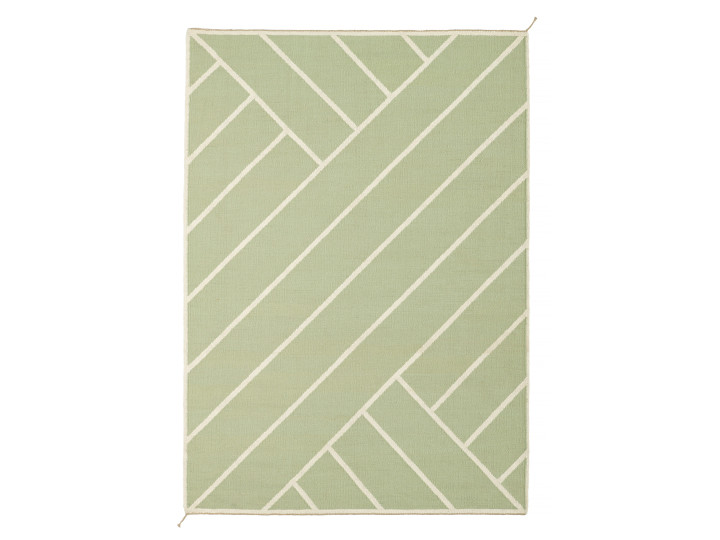Mid-modern scandinavian rug model VK2 olive / white
-
Vibeke Klint
-
Nordicmodern
- NM007 On demand. Delivery time 8-10 weeks
Mid-modern scandinavian rug model VK2 olive / white *Required step
In order to help you to choose, and to receive samples, do not hesitate to contact us by email: contact@galerie-mobler.com or by phone: 01 43 33 20 12
RUG VK-2
With the sea as inspiration
When Vibeke Klint had to design a rug, she usually started with a watercolor sketch.
The blue color was characteristic of Vibeke Klint, who was inspired by the view from her home and workshop in Taarbaek directly to the see, and by the changing blue, green and gray shades of the sea and sky.
Her rug VK-2 from the late 1970s is a good example of this. The rug was designed in the same period as her rug VK-1, which she designed for The Danish National Bank, and is characterized by a tight, minimalist geometric pattern in white diagonal stripes on a colored background. The minimalist pattern seems very simple, but the simpler a design is, the harder it is to weave. Nothing can be hidden. Then as today, only the most skilled weavers are able to weave with the precision needed for the design to work as intended.
In close collaboration with the Klint family, NORDICMODERN has recently put the original VK-2 rug design into production as part of their collection of selected Vibeke Klint designs.
The rug is available in 3 sizes and 4 colors.
| Dimensions | 140 x 200 cm / 170 x 240 cm / 200 x 300 cm |
| Material | wool |
| Style | Classique Neuf |
| Origin | Denmark |
| Fournisseur | Nordicmodern |
Vibeke Klint
Vibeke Klint (1927-2019)
The Queen of Weaving Art
The importance of the weaver Vibeke Klint for the good taste in official as well as private spaces cannot be overestimated. Her versatile production of rugs and other home textiles, the decoration of meeting rooms in significant buildings, concert halls, stage rooms, seminars, embassies, ministries and churches – all in detail designed, colored and materially selected by herself is impressive, but to this life’s work must be added her importance for passing on the craft and weaving traditions to younger generations.
She trained and educated numerous weavers, who today are offered assignments by architects and foundations that will give new spaces a unique identity in the form of a textile element.
Vibeke Klint got one of the pioneers of weaving art, Gerda Henning, as a teacher at the School of Arts, Crafts and Design at the Museum of Art and Design in Amaliegade, Copenhagen. Even before her departure in 1949, she was attached to Gerda Henning’s workshop. When Gerda Henning died suddenly in 1951, her husband, the sculptor Gerhard Henning, offered that Vibeke Klint could take over the workshop.
Through the Henning family, Vibeke Klint met her future husband, landscape architect Morten Klint, son of the legendary architect Kaare Klint, and in early 1957 the Klint family moved into their house in Taarbæk, which became both their private home and her workshop, where she worked with her weavers until 2008.
Over the years, Vibeke Klint worked closely with visual artists, furniture designers and architects, such as Finn Juhl and Borge Mogensen.
Her work is distinguished by an apparent simplicity, often with geometric shapes, acute angles and lines that are highlighted or toned down by the play of colors.
Her secret – which is no secret at all – is that she cultivated the beauty of simplicity. With her unique talent, she created her own form of minimalism.
Vibeke Klint’s exhibition activity in Denmark and abroad was overwhelming and she also participated in professional work as a member of boards of the Danish Design Council, the Arts and Crafts Council and the World Craft Council and for several periods she was on the Academy Council. In connection with Vibeke Klint’s 70th birthday in 1997, the book about Vibeke Klint was written by a former student, Inge Alifrangis, and in 2020, the year after Vibeke Klint’s death, the great work about Vibeke Klint written by weaver Gitte-Annette Knudsen, who worked as a weaver for Vibeke Klint from 2003-2008, was published. The book describes Vibeke Klint’s working life through 50 years and presents for the first time a series of Vibeke Klint’s sketches, watercolors and weaving samples, which give an impression of her working methods.
Vibeke Klint received numerous awards, one of the first was a silver medal at the Triennale in Milan in 1954, in 1960 she received the Lunning Prize, in 1972 she received the Eckersberg Medal, in 1978 the Knud V. Engelhardt Scholarship, in 1987 the Crafts Council’s Annual Prize, in 1989 C.F. Hansen Medal, 1992 Danmarks Nationalbank’s Honorary Scholarship and Ole Haslund’s Artist Foundation, in 1996 the Swedish Prince Eugene Medal and in 1997 the Lis Ahlmann Scholarship. In 2000, Vibeke Klint was appointed Knight of Dannebrog by the Queen og Denmark, Margrethe II.












